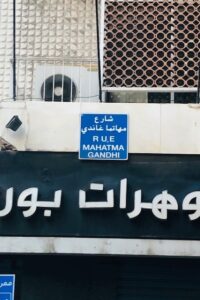Understanding Mass Violence in the Middle East
Laura Robson explains how mass violence came to be a constitutive element of the state and of political authority in the Middle East.
How should we understand the phenomenon (and, arguably, the centrality) of mass violence in the history of the modern Middle East? In the public sphere, Middle Eastern violence is often understood as the inevitable surfacing of longstanding sectarian or ethnic tensions inherent to the region; academic historians, by contrast, tend to treat it as an occasional symptom of social or economic malaise arising from (mainly) external causes. The first of these models – viewing violence as an inevitable expression of atavistic difference – is not just inadequate but actively wrong, as any number of scholars has shown. The second approach has been enormously useful for understanding specific local histories, but leaves unanswered questions about how violence emerged as pervasive feature of the twentieth century Mashriq across national borders, regimes, and long time spans.
Compounding the problem, the field of genocide studies, with its obsessive focus on determining which instances of mass violence “count” as genocide, has had vanishingly little to offer vis-à-vis the Middle East. And Middle Eastern history, with its longstanding commitment to profoundly nationalist frames of reference, has had its own limitations with regard to broad analytical questions like the cross-border prevalence of mass violence. To come to a more serious understanding of how mass violence came to be a constitutive part of the modern political experience of the region, then, we must re-integrate some of the separate national narratives that make up the field of Middle Eastern history as well as expand our understanding of large-scale violence beyond strict legal definitions of genocide. When we do this, we can see a new story, extending across the whole of the region in the modern era: a story about how modern empire in the Middle East installed state-sanctioned violence, especially ethnically or communally conscious varieties, at the heart of practices of governance in ways that have proven very difficult to reverse.

The process began at the end of the nineteenth century, as the late Ottoman empire was forced by various European threats to try to take tighter control over its territory. This moment marked the beginning of the end for the relatively loose and locally flexible rule that had mostly characterized the earlier Ottoman state, as the imperial government began to deploy force to assert a newly saturated kind of state authority. Further, because of the European practice of actively using client communities – mostly Ottoman Christians – as venues for foreign intervention in Ottoman affairs, this more vigorous Ottoman state-making now began to display an ethnic use of force within its own sphere. An increasingly violent approach to communities identified as European clients thus set the stage for a new and toxic relationship between the exercise of state authority and the use of ethnically aware violence in the nineteenth-century Middle East.
This relationship was significantly extended and expanded during the subsequent period of European colonization of the Mashriq, which ran roughly from WWI to the 1940s. Claiming to be “training” local populations for future democratic self-determination, British and French colonial administrations engaged in a truly astonishing level of brutality against civilians all over the region: bombing villages in Iraq, leveling the entire old city of Damascus, executing and assassinating intellectual and political leaders, bulldozing neighborhoods, murdering children – all accompanied by schemes that rigorously and violently segregated populations by ethnicity, language, and of course sect. This interwar European colonization thus deliberately and carefully installed and then demonstrated the idea that viable state governance rested above all on ethnically conscious displays of force, the more brutal the better.
In the post-1945 period, both authoritarian and semi-democratic governments across the region engaged in massive arms acquisition and then deployed many – in some cases most – of those weapons against their own populations. We usually understand this as a process of violent decolonization and then an equally violent postcolonial descent into either authoritarianism or fractured forms of democracy. But looking through the analytical lens of mass violence, it becomes apparent that this was a moment not of decolonization but of recolonization: a recasting of empire into new shapes in which superpowers controlled spaces by combining economic dominance with a flooding of weaponry into the relevant territory, alongside a careful political delineation of competing client populations. Mass violence – deployed with a specific view to ethnicity, nation, and sect – thus became as central to the recent enterprise of informal recolonization as it had been to the longer-ago practice of formal imperial rule.
The question of how to understand the history of mass violence in the Middle East – without recourse to discredited ideas about ancient enmities – is therefore of much more than academic interest. To appreciate how imperially sponsored mass violence came to be so deeply entangled with practices of state governance across the region, from Israel to Syria to Iraq, is crucial: not only to come to grips with the realities of the past, but to grasp the origins and nature of regional political authority in the present.
Further reading: The Politics of Mass Violence in the Middle East, by Laura Robson. Oxford University Press, 2020.



0 Comments